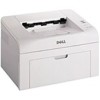Dell 1100 Laser Mono Printer Dell™ Laser Printer 1100 User's Guide - Page 22
Guidelines for Paper and Special Materials, Paper Type, Input Mode/Capacity, Automatic Feed
 |
View all Dell 1100 Laser Mono Printer manuals
Add to My Manuals
Save this manual to your list of manuals |
Page 22 highlights
Paper Type Plain Paper Envelopesb Labelsb Transparenciesb Card Stockb Input Mode/Capacitya Automatic Feed 150 - Manual Feed 1 1 1 1 1 a. Maximum capacity may be reduced depending on the paper thickness. b. If you load more than one sheet, paper jams will occur. You must load only one sheet at a time in the tray. Guidelines for Paper and Special Materials When selecting or loading paper, envelopes, or other special material, keep these guidelines in mind: Attempting to print on damp, curled, wrinkled, or torn paper can cause paper jams and poor print quality. Use only high-quality, copier-grade paper for the best print quality. Avoid paper with embossed lettering, perforations, or a texture that is too smooth or too rough. Paper jams may occur. Store paper in its ream wrapper until you are ready to use it. Place cartons on pallets or shelves, not on the floor. Do not place heavy objects on top of the paper, whether it is packaged or unpackaged. Keep paper away from moisture, or other conditions that can cause it to wrinkle or curl. Store unused materials at temperatures between 15°C and 30oC (59°F to 86°F). The relative humidity should be between 10% and 70%. During storage, you should use moisture-proof wrap, such as a plastic container or bag, to prevent dust and moisture from contaminating your paper. Load special paper types one sheet at a time. Only use materials specifically recommended for use with laser printers. To prevent special materials, such as transparencies and label sheets, from sticking together, remove them as they print out. For envelopes:















